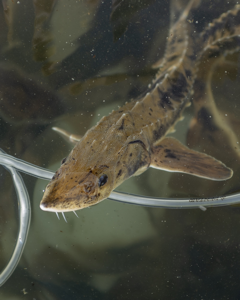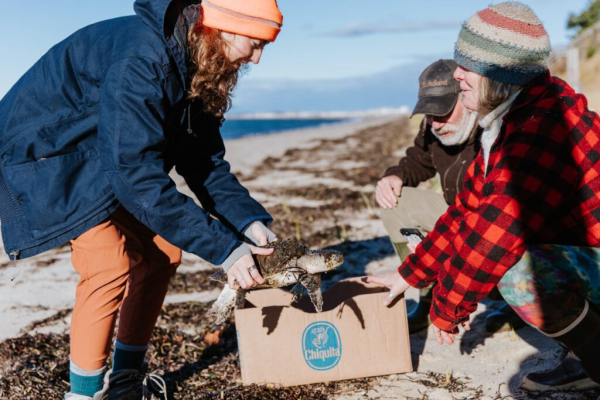Tennessee: Tennessee Aquarium, Partners Release Sturgeon into Tennessee River

Chattanooga, TN – Beneath cornflower blue skies and surprisingly balmy weather on Friday afternoon, a group of scientists released about 100 baby dinosaurs into the chilly waters of the Tennessee River near downtown Chattanooga.
The team worked quickly and efficiently to shift dozens of juvenile Lake Sturgeon into the river from the water-filled plastic bins that were used to transport them to the release site from the Tennessee Aquarium Conservation Institute. The move was the culmination of more than a year of continuous care by Aquarium scientists.
This release was a bright moment in a year that has seen significant upheaval and hurdles thanks to the pandemic, says Dr. Anna George, the Aquarium’s vice president of conservation science and education.
“This has been an exceptionally challenging year,” George says. “That said, we’ve still been able to keep up with most of our active conservation and research programs. While we’ve had to adapt most of our protocols, from number of people in a field truck to moving conferences online, we’re figuring out new ways to accomplish our mission.”
As they surged into the water at the bottom of the Coolidge Park boat ramp, the juvenile Lake Sturgeon were just a shadow of the river giants they could one day become. With a potential life span of up to 150 years, these little fish could eventually grow to nine feet and tip the scales at 300 pounds.
Usually, Lake Sturgeon spend several months in human care before being released. By that time, they are about six inches long. The fish released Friday, however, were larger thanks to an additional year spent in human care. This extra time was to ensure they were large enough to safely draw their blood as part of a study designed to examine their genetic health.
Lake Sturgeon once thrived in the Tennessee River, and still look similar to their ancestors who swam with dinosaurs, earning them the scientific distinction as “living fossils.” The fish that entered the river Friday are the most recent “graduates” of a 22-year program to restore the species to the Tennessee and other waters from which it had all but disappeared in the latter half of the 20th century.
By the 1970s, Lake Sturgeon had been pushed to the brink by overfishing, pollution and damming of the Tennessee River, Cumberland River and their tributaries. By 1998, changes to clean water legislation and river management practices had improved these waterways as a potential habitat, leading to the formation of the Lake Sturgeon Working Group and the start of the ongoing restoration effort.
Last year, the Aquarium and its many partners celebrated a major milestone with the release of the 250,000th Lake Sturgeon raised by the Lake Sturgeon Working Group. With this year’s release, the Aquarium alone is responsible for returning more than 30,000 of these future river giants back to their ancestral waters.
Despite adapting nimbly to an ever-changing landscape, the Lake Sturgeon program was still affected by the pandemic. For the first time in 20 years, the partners in the Lake Sturgeon Working Group were unable to visit the Wisconsin rivers where Lake Sturgeon are spawned and their eggs hatched to produce a new class of juveniles.
As a result, this summer was the first in two decades that no new Lake Sturgeon were raised at the Aquarium.
“That was disappointing for all of us,” George says.
Nevertheless, challenges are inherent to long-term scientific work. Worldwide pandemics are a once-in-a-generation event, but the effort to restore an imperiled species is undertaken with the understanding that the sailing will rarely be smooth nor the journey short.
“We knew when we started working with Lake Sturgeon that this would be at least a 25-year endeavor, and possibly longer depending on what challenges we encountered,” George adds. “Now that we’re 20 years into the program, we’ve learned a lot about raising sturgeon in our facility, what types of river habitat they prefer once released and that they are safely moving throughout most of the Tennessee River mainstem.
“While we know we’ll be raising and releasing fish for at least three to five more years, it’s amazing to me how far we’ve already come. Pretty soon, we might have a year where we can start devoting that kind of attention to a different species that needs a little extra help to come back from the brink.”
Partners in the Southeastern Lake Sturgeon Working Group include:
- U.S. Fish and Wildlife Service
- Tennessee Wildlife Resources Agency
- Tennessee Valley Authority
- U.S. Geological Survey
- The Tennessee Aquarium
- Tennessee Technological University
- University of Tennessee at Knoxville
- Conservation Fisheries Inc.
- Kentucky Department of Fish & Wildlife Resources
- Georgia Department of Natural Resources
- North Carolina Wildlife Resources Commission
- The Tennessee Clean Water Network
- Wisconsin Department of Natural Resources
- World Wildlife Fund
For more information about the work of the Tennessee Aquarium Conservation Institute, visit tnaqua.org/conserve/






